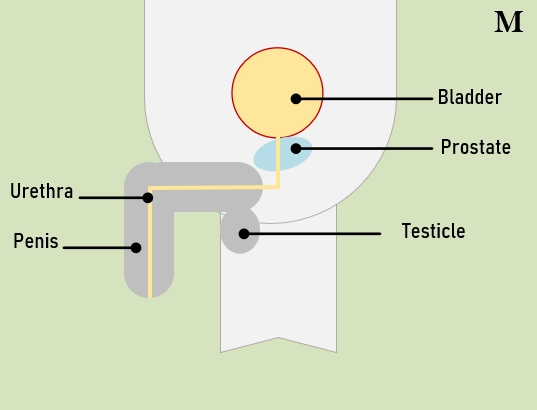Summary :
◉ Bladder: what is it ?
The bladder is an important part of the urinary system of the human body, responsible for storing and releasing urine. This muscular sac is located in the pelvic region and is connected to the kidneys by two tubes called ureters and to the outside of the body by the urethra.
When the bladder is empty, it collapses into a small, compact shape. However, as urine accumulates, the walls of the bladder stretch and expand, creating pressure that signals the need to empty it.
By staying hydrated, avoiding irritants, and exercising regularly, you can help maintain a healthy bladder and prevent problems from developing.
If you experience symptoms such as frequent urination, pain during urination, or blood in the urine, it is important to see a doctor.

◉ Anatomy: where is the bladder located?
The bladder is a hollow triangle-shaped organ located in the lower abdomen, just above and behind the pubic bone.
- In men: it is in front of the seminal vesicles and the rectum and above the prostate.
- In women: it is in front of the uterus and vagina, and above the pelvic diaphragm.
The muscular walls of the bladder relax and expand to store urine, and contract and flatten to empty urine through the urethra. It is also equipped with a coating of mucous tissues which protects it against irritating substances in the urine and prevents bacterial infiltration.
The bladder of a typical healthy adult can store up to two cups of urine (400 to 600 milliliters) for two to five hours.
◉ Bladder diseases
The bladder can be affected by various diseases and infections that can alter its normal functioning:
- Bladder inflammation (Cystitis): is a common condition that can be caused by a variety of factors, including bacterial infections.
- Interstitial cystitis: Also known as painful bladder syndrome, this is a chronic condition that causes discomfort, pressure or pain in the bladder and pelvic area.
- Bladder Cancer: According WCRF, it is the 10th most common cancer in the world. The main symptom is the presence of blood in the urine (hematuria)
- Bladder stones: are urinary stones located in the bladder and can cause pain, urination problems, etc.
- Neurogenic bladder: This is a malfunction of the bladder caused by neurological damage. The main symptom is urinary incontinence.
- Cystocele (descent of the bladder): displacement of the bladder out of its natural place, it occurs when the muscles and tissues that support the bladder become weak or damaged.
- Polyp: This is a type of growth that consists of abnormal tissue. It's polyps are usually benign (non-cancerous).
◉ Symptoms
Bladder problems can cause a variety of symptoms, depending on the type of problem and its severity. :
- A need to urinate more often than usual
- Pain or burning sensation during urination
- Pressure or pain in the lower abdomen
- Pain during sex
- Urinary Incontinence
- Blood in the urine: eg in case of bladder cancer.
- Cloudy or strong-smelling urine
- Abdominal pain: e.g. in case of bladder stones
Note : It is important to note that while these symptoms may indicate a bladder problem, they may also be caused by other underlying conditions.
◉ Exams and Tests to Check the Bladder
There are several tests that can be used to diagnose bladder problems, including :
- Urinalysis: consists of analyzing a person's urine to detect a possible urinary tract infection.
- Cystoscopy: This is a procedure that involves inserting a fiber optic instrument to view the inside of the bladder and urinary tract.
- Urodynamic tests: These tests measure the function of the bladder, including the ability to hold and release urine and the pressure in the bladder.
- X-ray : Ultrasound, CT scan or other to produce images of the bladder and surrounding organs.